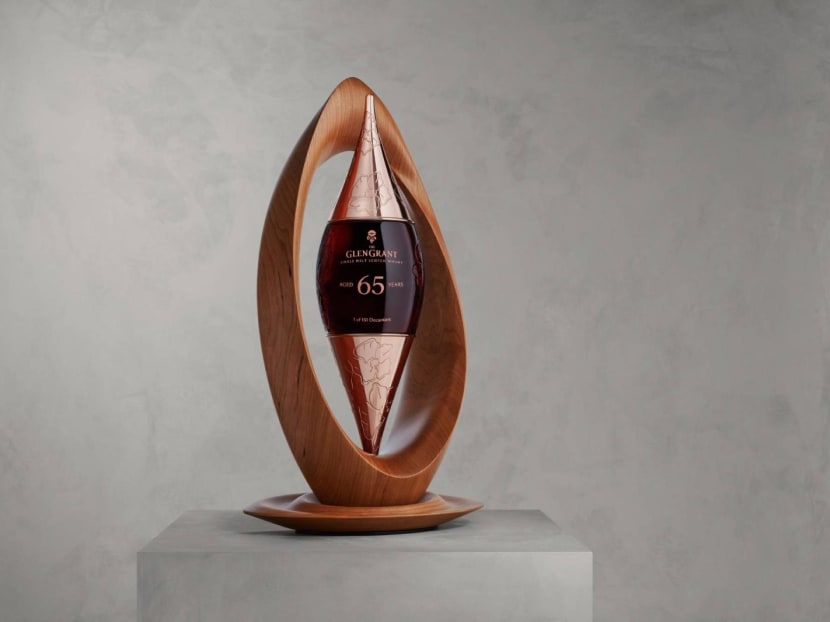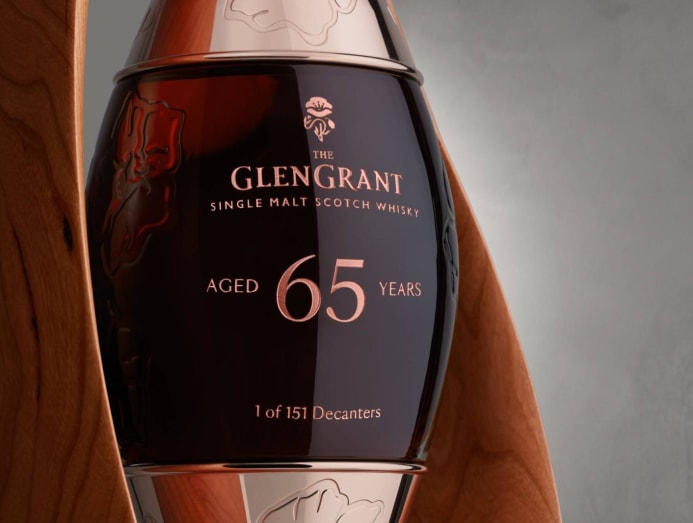Glen Grant releases the rarest whiskies ever: 65-year-old single malt Scotch whisky
Only 151 decanters of whisky were made, of which 12 were earmarked for Singapore.

Encased in a bespoke decanter, the Glen Grant 65-Year-Old is one of the oldest whiskies released by the distiller. (Photo: Glen Grant)

This audio is generated by an AI tool.
Speyside distiller Glen Grant is making a grand foray into the world of ultra-premium whiskies with the recently announced Splendours Collection. The distillery unveiled the first of the collection: The Glen Grant 65-Year-Old. Encased in a bespoke decanter, the mahogany-hued liquid is one of the oldest whiskies released by the distiller.
“The Glen Grant 65-year-old is at its peak,” said Greig Stables, master distiller at Glen Grant. “It epitomises Glen Grant and introduces a completely new dimension. It is a great way to launch the Splendours Collection.”
Stables, who succeeded the legendary Dennis Malcolm OBE in 2024, made his inaugural visit to Singapore to unveil the whisky. Only 151 numbered decanters of this rare expression are released in 700ml formats, available at S$67,500 (US$50,000). Of these, 50 decanters are earmarked for the APAC region, and 12 are for Singapore.
This 65-year-old spirit was distilled in 1958 when the pot stills were fired by coal, poured into a single French oak butt and matured in Warehouse No.4, Glen Grant’s oldest traditional stone dunnage warehouse, for six and a half decades. Over time, Stables informed us that only 15 per cent to 20 per cent of the spirit remained (the rest was lost to angel's share) and was then bottled at a cask strength of 55.5% abv.

Stables stated: “Although distilled back in 1958, the methods remain almost entirely the same today, reflecting the legacy of our forefathers. This whisky captures a lifetime of flavour and character from its journey in a single French oak butt retaining the distinct and singular character of The Glen Grant.”
With this launch, the Glen Grant 65-Year-Old joins a small but distinguished group of sexagenarian releases, including the Macallan Fine & Rare 65-Year-Old and The Dalmore 60-Year-Old, both of which have set the bar for the most coveted, high-priced bottles in the whisky world.
THE GARDEN OF SPLENDOURS
The Splendours collection references Glen Grant’s beautiful Garden of Splendours, planted over a century ago by founder Major James Grant. A seasoned world traveller, he journeyed the globe and collected exotic fruits and flowers along his adventures, many of which grow in the botanical haven.
Among them is the Himalayan blue poppy, one of the rarest flowers, which is now the centrepiece of the brand’s visual identity and has been adopted as the new Glen Grant logo. Each edition of the collection will reference natural elements from the garden.
The 65-year-old whisky, in particular, pays tribute to the Himalayan blue poppy. The flowers are etched into the hand-blown decanters designed by Brodie Nairn of Glasstorm, a long-time collaborator of the distillery. The decanter, shaped like a seed pod, is set in a sleek cherry wood eternity design inspired by the Mobius strip and symbolises the continuous loop of nature. “It’s a nod to the Major and his travels around the world.” Stables explained. “He always came back to the starting point, his garden.”
TRADITION MEETS INNOVATION
The story of Glen Grant began in 1840 when brothers John and James Grant launched the distillery in Rothes, Speyside. In 1872, James Grant introduced innovations that would define the distillery’s future.
Under the James’ leadership, Glen Grant became the first distillery to use electricity and implemented distinctly tall, slender pot stills to capture a lighter expression of the spirit. His decision to add water purifiers to the stills was another forward-thinking move that helped create Glen Grant’s signature style.
“In these stills, the Major created the DNA of Glen Grant – this light, fruity, floral spirit,” shared Stables, who now carries on the distillery’s legacy. As master distiller, he is responsible for running the distillery and also the creation of each drop of single malt. “My job is to ensure that every time you taste a Glen Grant, be it the Arboralis, right through to the 30-year-old, you recognise that DNA and that fruity flavour is present all the time.”

He exercises his pursuit for quality and impeccable craftsmanship across the range. For his next creation, a more modest 15-year-old, he is set to nose through a selection of 150 casks upon his return to Scotland.
Today, the distillery also exhibits a strong commitment to sustainability. Under the Campari Group, which bought the distillery in 2006, Glen Grant is working towards net-zero carbon emissions. “We spent £3.5 million (S$6 million) last year to reduce our gas consumption by 20 per cent, and water consumption is down by 50 per cent”, he added.
THE ELIXIR
The tasting notes describe the complexity of this whisky. Sweet aromas of syrupy treacle on the nose and juiciness of ripe blackberries and sandalwood. Vibrant orange and ripe black cherries, indulgent fruit cake and sticky dates unfold on the palate. The finish lingers with light spice and oak, rounded off with a subtle hint of smoke.
While Glen Grant does not peat its whiskies now, Stables noted that they used to peak the malt in 1958, which explains the faint smokiness present in this expression.
Stables then shared his evocative private impressions with us: “The liquid is quite unbelievable. When you take a sip, the flavours go on and on, and it never leaves you. Once your glass is empty, you go back and nose it, and it just takes you back to the journey you’ve just had. The depth of the flavour is just tremendous.”
As for what’s next in the Splendours Collection, he remained tight-lipped. “We have a great selection of older casks, and this is just the beginning of the new series, the Splendours Collection,” he teased.








